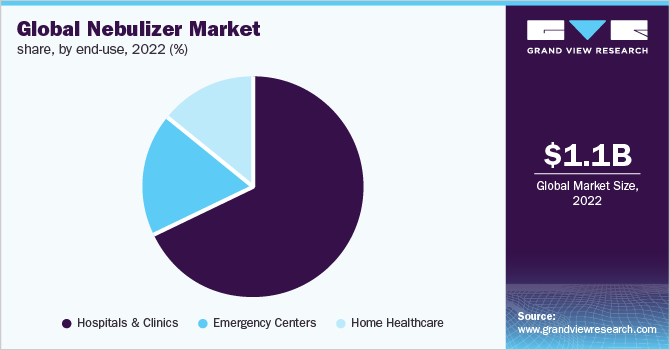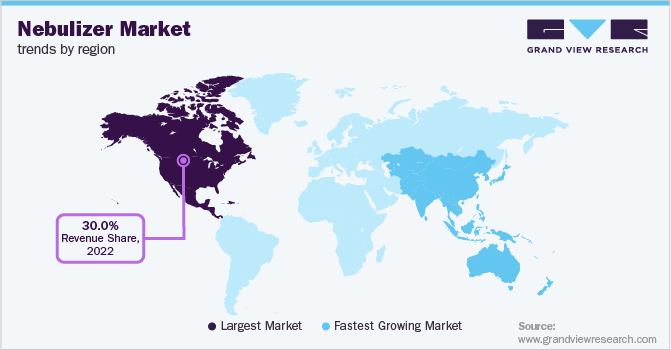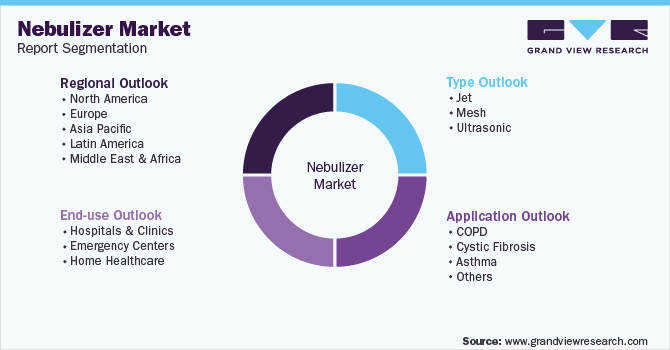- Home
- »
- Medical Devices
- »
-
Nebulizer Market Size, Share & Growth Analysis Report, 2030GVR Report cover
![Nebulizer Market Size, Share, & Trends Report]()
Nebulizer Market Size, Share, & Trends Analysis Report By Type (Jet, Mesh, Ultrasonic), By Application (COPD, Asthma, Others), By End-use (Hospitals & Clinics, Emergency Centers), By Region, And Segment Forecasts, 2023 - 2030
- Report ID: GVR-2-68038-069-9
- Number of Report Pages: 150
- Format: PDF, Horizon Databook
- Historical Range: 2018 - 2021
- Forecast Period: 2023 - 2030
- Industry: Healthcare
Report Overview
The global nebulizer market size was estimated at USD 1.07 billion in 2022 and is anticipated to expand at a compound annual growth rate (CAGR) of 5.9% from 2023 to 2030. The high growth is attributed to the rising incidence rate of chronic respiratory diseases, increasing demand for home healthcare devices, and the rising geriatric population. As per the Centers for Disease Control and Prevention, Chronic Obstructive Pulmonary Disease (COPD) is the fourth leading cause of death in the U.S. Moreover, the rising consumption of alcohol, tobacco, and ultra-processed products, including sugar-sweetened beverages, among others is a major cause behind the increasing prevalence of respiratory diseases in North America. According to the Centers for Disease Control and Prevention (CDC) data, about 14% of deaths in adults aged 30 to 70 years in North America are caused due to tobacco consumption. Thus, an increase in the number of smokers and environmental pollution is anticipated to increase the demand for nebulizers.

In addition, as per WHO, in 2019, there were around 3.23 million deaths worldwide due to COPD. However, initiatives such as the “Global Alliance against Chronic Respiratory Diseases” are likely to improve diagnosis and treatment rates of respiratory disorders, which may, in turn, boost the market for nebulizers.
The COVID-19 outbreak has affected millions of people around the world. The pandemic has compelled the healthcare industry to take emergency actions, with a race to develop therapeutic and preventive interventions. Asthma or COPD patients, who were aware of the risk of airborne transmission of COVID-19, were hesitant about the use of inhaled medications, which are considered a potential source of viral transmission and immunosuppression. However, medical practitioners advised all such patients to continue using their prescribed inhaled medications, including nebulizers. Nebulized albuterol was recommended in some parts of the U.S. as an alternative to albuterol rescue inhalers when pharmacies faced a shortage of albuterol inhalers.
The Russia-Ukraine conflict hindered the possibility of a COVID-19 pandemic-related economic rebound globally, at least in the short term. Economic restrictions on several countries, a rise in commodity costs, and supply chain disruptions due to the conflict between these two nations have all had an impact on global markets.
In addition, many pharmaceutical corporations are focusing on developing effective treatments to treat the COVID- 19 viruses, which will be primarily administered via a nebulizer. For instance, In May 2021, Inspira Pharmaceuticals and Vectura declared a collaboration to develop a potential inhalation-based COVID-19 therapy. Under this contract, Vectura will test IPX formulation delivery to lungs through its FOX vibrating mesh nebulizer.
The market for a nebulizer and respiratory devices is quite mature with jets dominating the market due to their low cost. Hence, other nebulization devices are expected to experience high competition. Furthermore, it is a challenge for new technology or device to gain momentum in mature markets, particularly with the intricacies of different reimbursement and national regulatory systems that need to be followed for both drugs as well as devices.
Furthermore, it is a challenge for new technology or device to gain momentum in mature markets, particularly with the intricacies of different reimbursement and national regulatory systems that need to be followed for both drugs as well as devices. Mesh nebulizers are more expensive than jet nebulizers because of the increased number of tolerances, components, critical parts, and assemblies related to both mesh and electronic control circuits. Besides, increasing applications of mesh nebulizers in clinical trials since 2006 by major companies such as Philips, Vectura, and Pari Gmbh are expected to boost the market growth in the near future.
Medicare Part B covers the cost of nebulizers and the cost of a few nebulizer medicines that are considered necessary. Under Part C, coverage is provided for medically-necessary nebulizers. Medicare reimburses 75% of the manufacturer’s suggested retail price for durable medical equipment. Nebulizers are classified as durable medical equipment by Medicare. Initiatives are being undertaken by the government, and non-government organizations to streamline the diagnosis and treatment of respiratory disorders further support market growth. For instance, the GARD is a voluntary alliance of national and international organizations to cure respiratory disorders.
Furthermore, companies are aiming to address the low awareness around nebulization in acute disease management, which further fuels market growth. Hence, several organizations are launching campaigns to raise awareness of respiratory disorders' treatment alternatives. For instance, in December 2021, Cipla Limited revealed a first-of-its-kind initiative to enhance access to nebulization therapy, particularly for patients in the rural parts of India. Likewise, OMRON will roll out Experience Centers with customer support contact points in major cities in India to provide consumers with hands-on experience with OMRON products to raise consumer awareness about the effectiveness of nebulizers.
Type Insights
Jet nebulizers are expected to account for the largest share in the global nebulizer market over the forecast period owing to the low cost of the devices. Besides, the ease of handling nebulizers and efficient design for drug delivery has made jet nebulizers the prime segment over the years. Jet nebulizers are effective in delivering formulations that cannot be delivered with dry powder inhalers and pressurized metered-dose inhalers. In addition, nebulizers are available in various designs including jet nebulizers along with corrugated tubes, collection bags, breath-enhanced, and breath-actuated jet nebulizers, and others
The mesh nebulizers segment is expected to witness lucrative market growth over the forecast period due to the technologically advanced compact size devices and minimized drug loss. The market for mesh nebulizers is expected to grow further, majorly due to increased patient acceptance, quick treatment, portability, and convenience. Furthermore, increasing commercial acceptance of mesh nebulizers due to accurate drug delivery to the lung and lower residual volumes also aid in market penetration. Some of the products offered by the key players in the market are Omron Corporation’s MicroAIR U100 (compact, travel-ready, with mesh technology), Philips Healthcare’s Aeroneb Go (Portable nebulizer based on Aerogen’s vibration mesh technology for patients requiring respiratory aerosol therapy.
Application Insights
COPD is expected to account for the largest share in the global nebulizer market over the forecast period owing to the growing prevalence of COPD. Recent improvements in technology have made nebulizers more portable and patient friendly. Additionally, various medication types are widely available in nebulized formulations, including long-acting beta2-agonists (LABAs), long-acting muscarinic receptor antagonists, steroids, mucolytics, and antibiotics. These features have made it possible for people with COPD to utilize nebulizers outside of acute settings like clinics or hospitals, in turn, drives the segment growth. Companies’ R&D activities in advancing technologies further stimulate segment growth. For instance, in January 2021, Wellinks publicized that the wireless nebulizer for use by individuals with COPD has been cleared by a review board of the U.S. FDA. Wellinks is on a mission to reinvent respiratory care around the population.
The Asthma segment is expected to witness lucrative market growth over the forecast period. Asthma is a non-communicable disease, affecting both children and adults, and is a common chronic disorder among children. Asthma has emerged as one of the most prevalent respiratory conditions worldwide due to the increase in pollution in most nations and regions. The WHO estimates that 339 million people worldwide are affected by this illness, and that number keeps rising. The growing prevalence of asthma globally, coupled with government organizations and NGO activities for creating awareness are some of the factors boosting the segment's growth.
End-use Insights
Hospitals are expected to account for the largest share in the global nebulizer market over the forecast period owing to the favorable reimbursement policies and larger patient footfall. Hospitals are an integral part of the healthcare industry and are the major revenue source for the entire industry. Therefore, multiple companies invest substantial efforts, both in terms of marketing strategies and revenue, to endorse their product/services among the hospitals.
Besides, in December 2021, Cipla Limited revealed an initiative to enhance access to nebulization therapy for acute asthma management in primary healthcare centers of rural India. Thus, such projects boost segment growth.

Home healthcare devices have been gaining popularity and market share in recent years. Miniaturization of products and technological advancements are boosting the adoption of home healthcare devices. Furthermore, the growing geriatric population, high incidence of target diseases, and growing need to curb healthcare expenditure are expected to be some of the high-impact rendering drivers for home healthcare devices. Home healthcare is a cost-effective alternative to expensive hospital stays, which is expected to boost the nebulizer market. The easy availability of compact nebulizers that are ideal for home use and technological innovations in nebulizers to reduce the sound created by them and to improve their functionality are increasing their adoption in home healthcare.
Regional Insights
North America commanded over 30% share of the nebulizer market in 2022 owing to growing respiratory disorders and efforts by the government such as favorable reimbursement scenarios, a rise in customer awareness, and a well-established healthcare infrastructure. Furthermore, the introduction of technologically advanced devices and favorable reimbursement scenarios in this region is expected to fuel market growth in this region. Moreover, the rise in the geriatric population in the U.S. is leading to a corresponding growth in the number of surgeries in the country, which further boosts the regional market growth. For instance, the number of Americans ages 65 and older will more than double over the next 40 years, reaching 80 million in 2040

However, Asia Pacific is expected to be the fastest-growing market over the forecast period owing to the large geriatric population, increasing focus on preventive care, and government initiatives promoting technological innovations. The rise in healthcare expenditure and increase in patient awareness in the region have created demand for these devices. Low-cost manufacturing sites and favorable taxation policies in the region’s countries have been successful in attracting foreign players to this market. In addition, the rise in medical tourism in countries such as India, the Philippines, Malaysia, and Singapore has aided the regional overall growth.
Key Companies & Market Share Insights
The nebulizer market is a mature market with major players such as Omron, Koninklijke Philips, and PARI. However, the introduction of technologically advanced mesh nebulizers has created many opportunities for the companies such as Vectura Group, PARI Pharma, and others. Many pharmaceutical companies are also using mesh nebulizers for drug development. For instance, as per the analysis of the U.S. and Europe clinical trial databases, mesh nebulizers are preferred for clinical trials sponsored by pharmaceutical companies over jet nebulizers.
To differentiate their products from the other market players, companies are adopting strategies such as new product development, acquisitions, and collaboration with other players or research institutes. For instance, in March 2021, PARI Pharma GmbH, a business that specializes in cutting-edge aerosol delivery systems based on eFlow Technology declared the LAMIRA Nebulizer System authorization in Japan. The LAMIRA Nebulizer System is the only device designed to deliver ARIKAYCE since it is specifically suited for it. Likewise, in July 2020, OMRON Corporation announced the OMRON NE C106, the addition of a new device to their nebulizer portfolio. Some of the prominent players in the global nebulizer market include:
-
Omron Corporation
-
GE Healthcare
-
Koninklijke Philips N.V.
-
Allied Healthcare
-
Vectura Group Plc.
-
PARI Respiratory Equipment, Inc.
-
Aerogen
-
DeVilbiss Healthcare LLC
-
Briggs Healthcare
-
Beurer GmBH
Nebulizer Market Report Scope
Report Attribute
Details
Market size value in 2023
USD 1.14 billion
Revenue forecast in 2030
USD 1.70 billion
Growth rate
CAGR of 5.9% from 2023 to 2030
Base year for estimation
2022
Historical data
2018 - 2021
Forecast period
2023 - 2030
Quantitative units
Revenue in USD million and CAGR from 2023 to 2030
Report coverage
Revenue forecast, company ranking, competitive landscape, growth factors, and trends
Segments covered
Type, application, end-use, region
Regional scope
North America; Europe; Asia Pacific; Latin America; MEA
Country scope
U.S.; Canada; Germany; U.K.; France; Italy; Spain; Denmark, Sweden, Norway, China; Japan; India; Thailand; Australia;South Korea; Brazil; Mexico; Argentina; South Africa; Saudi Arabia; UAE; Kuwait
Key companies profiled
Omron Corporation; GE Healthcare; Koninklijke Philips N.V.; Allied Healthcare; Vectura Group Plc.; PARI Respiratory Equipment, Inc.; Aerogen; DeVilbiss Healthcare LLC; Briggs Healthcare; Beurer GmBH
Customization scope
Free report customization (equivalent up to 8 analysts working days) with purchase. Addition or alteration to country, regional & segment scope.
Pricing and purchase options
Avail customized purchase options to meet your exact research needs. Explore purchase options
Global Nebulizer Market Segmentation
This report forecasts revenue growth at global, regional, & country levels, and provides an analysis of the industry trends in each of the sub-segments from 2018 to 2030. For this study, Grand View Research has segmented the global nebulizer market report based on type, application, end-use, and region:

-
Type Outlook (Revenue, USD Million, 2018 - 2030)
-
Jet
-
Mesh
-
Active
-
Passive
-
-
Ultrasonic
-
-
Application Outlook (Revenue, USD Million, 2018 - 2030)
-
COPD
-
Cystic Fibrosis
-
Asthma
-
Others
-
-
End-use Outlook (Revenue, USD Million, 2018 - 2030)
-
Hospitals And Clinics
-
Emergency Centers
-
Home Healthcare
-
-
Regional Outlook (Revenue, USD Million, 2018 - 2030)
-
North America
-
U.S.
-
Canada
-
-
Europe
-
UK
-
Germany
-
France
-
Italy
-
Spain
-
Denmark
-
Norway
-
Sweden
-
-
Asia Pacific
-
Japan
-
China
-
India
-
Australia
-
Thailand
-
South Korea
-
-
Latin America
-
Brazil
-
Mexico
-
Argentina
-
-
Middle East & Africa
-
South Africa
-
Saudi Arabia
-
Kuwait
-
UAE
-
-
Frequently Asked Questions About This Report
b. The global nebulizer market size was estimated at USD 1.07 billion in 2022 and is expected to reach USD 1.14 billion in 2023.
b. The global nebulizer market is expected to grow at a compound annual growth rate of 5.9% from 2023 to 2030 to reach USD 1.70 billion by 2030.
b. North America commanded over 30% share of the nebulizer market in 2022 owing to growing respiratory disorders and efforts by the government such as favorable reimbursement scenarios, a rise in customer awareness, and a well-established healthcare infrastructure.
b. Some key players operating in the nebulizer market include Omron Corporation; GE Healthcare; Koninklijke Philips N.V.; Allied Healthcare; Vectura Group Plc.; PARI Respiratory Equipment, Inc.; Aerogen; DeVilbiss Healthcare LLC; Briggs Healthcare; and Beurer GmBH.
b. Key factors that are driving the nebulizer market growth include the rising incidence rate of chronic respiratory diseases, increasing demand for home healthcare devices, and rising geriatric population.
Share this report with your colleague or friend.
![gvr icn]()
NEED A CUSTOM REPORT?
We can customize every report - free of charge - including purchasing stand-alone sections or country-level reports, as well as offer affordable discounts for start-ups & universities. Contact us now
![Certified Icon]()
We are GDPR and CCPA compliant! Your transaction & personal information is safe and secure. For more details, please read our privacy policy.
We are committed towards customer satisfaction, and quality service.
"The quality of research they have done for us has been excellent."





